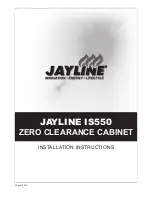
41
Heat & Glo • XLR-N-CE, XLR-PB-CE • 2198-900 Rev. L • 3/13
11
Gas Information
A. Gas Pressure Requirements
Pressure requirements for XLR-CE fireplaces are shown
in Table 11.1 below.
Two taps are provided on the right hand side of the gas
control for a test gauge connection to measure the inlet
and outlet pressures.
The fireplace and its individual shut-off valve must be dis-
connected from the gas supply piping system during any
pressure testing of the system at test pressures in excess
of 60 mbar.
If the fireplace must be isolated from the gas supply pip-
ing system by closing an individual shut-off valve, it must
be of the handle-less type.
Incoming gas line should be piped into the valve compart-
ment and connected to the ISO 7-Rp 1/2 (BSP Rp 1/2)
threaded gas inlet connection on the manual shutoff valve.
Leak test all gas line points and the gas control valve prior
to and after starting the gas appliance.
B. Gas Connection
Note:
Have the gas supply line installed in accordance with
local building codes by a qualified installer approved and/or
licensed as required by the locality.
Note:
Before the first firing of the appliance, the gas supply
line should be purged of any trapped air.
Note:
Consult local building regulations to properly size the gas
supply line leading to the (Rp 1/2 in.) hook-up at the unit.
WARNING
CHECK FOR GAS LEAKS
Explosion Risk
Fire Risk
Asphyxiation Risk
• Check all fittings and connections.
• Do not use open flame.
• After the gas line installation is complete, all
connections must be tightened and checked
for leaks with a commercially-available, non-
corrosive leak check solution. Be sure to rinse
off all leak check solution following testing.
Fittings and connections may have loosened
during shipping and handling.
WARNING
Fire Risk
Explosion Risk
High pressure will damage valve.
• Disconnect gas supply piping BEFORE
pressure testing gas line at test pressures
above 60 mbar.
• Close the manual shutoff valve BEFORE
pressure testing gas line at test pressures
equal to or less than 60 mbar.
Figure 11.1. Valve Components
Natural Gas
(G20)
Propane
(G31)
Propane
(G31)
Butane
(G30)
Butane
(G30)
Natural Gas
(G25)
CAT
I
2H,
I
2E,
I
2E+
I
3P
I
3P
I
3B/P
I
3B/P
I
2E+
Inlet Pressure
20 mbar
30 mbar
50 mbar
30 mbar
50 mbar
25 mbar
Burner Pressure
8.7 mbar
25 mbar
25 mbar
25 mbar
25 mbar
8.7 mbar
Gas Rate
.405
m3
/
h
.134
m3
/
h
.134
m3
/
h
.111
m3
/
h
.111
m3
/
h
.40
m3
/
h
Heat Input (Net)
7.32 kW
6.74 kW
6.74 kW
6.44 kW
6.44 kW
7.32 kW
Burner Injector
DMS 42
DMS .057
DMS .057
DMS 55
DMS 55
DMS 42
Pilot Injector
51
30
30
30
30
51
Columns highlighted in gray = The gas control valve supplied with this product is approved for a maximum
inlet pressure of 37 mbar. For pressures over 37 mbar, an in line pressure regulator must be installed
upstream from the gas control valve.
GAS VALVE
CONTROL
MODULE
ON/OFF/REMOTE
SWITCH
DC ADAPTER
BATTERY
PACK
C. Access Through the Valve Assembly
Refer to Section 16.C.
There is a vent hole on the regulator to equalize the
pressure on the diaphragm. It also a small amount of
air in the top side of diaphragm to keep the pressure
readings more consisent. This
not
for gas leakage.
















































